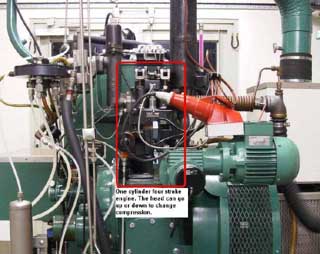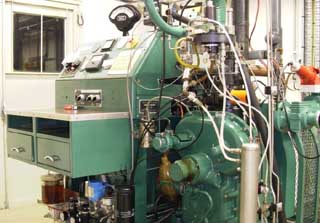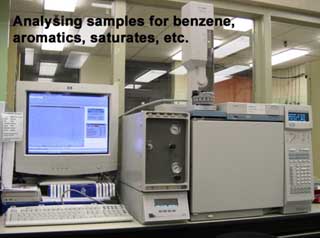To obtain gasoline a refinery needs to chemically alter naphta into a product called Platformate (something that looks like M70 or M80 when speaking of industrial codes). Basically what happens are chemical reactions to change the low aromatic naphta into a high aromatic platformate. Side effect is the formation of hydrogen which will be used somewhere else in the refinery. By controlling the chemical reactions one can control the specifications of platformate.
Most interesting specifications are the percentage of aromatics which can be brought up to 80% (whereas naphta has about 5-10%) and the RON which can be brought up to about 102 or more when needed. Platformate is not gasoline, but it is a main ingredient of it.
Gasoline contains about 40-60% platformate, depending of the kind of gasoline (SuperPlus or Eurosuper. Regular gasolines are rare these days.) The other ingredients are: butane, naphta, iso-pentane and sometimes MTBE which is a kind of alcohol. Additives will be added in a later stadium but normally not at production time.

So, you have platformate, butane, naphta, iso-pentane and perhaps MTBE. Now it's time to mix them into a nice product called gasoline.
Since the climatic conditions differ country from country and season from season, each country has their own specifications to which the gasoline has to comply. Also national and international regulations will take care of environmental and durability (of both the engine and the gasoline) issues. All these specifications are combined into an industrial code.
Winter specification EuroSuper for the Netherlands is E60, for Belgium it's E61 and for Germany it's E70. All codes starting with the same first number are called a group, so E60 and E61 are group members. The difference between the specifications in a group are marginal, so a refinery might want to produce gasoline that meets the specification of all the group members. The difference between E6 and E70 is also marginal (you wouldn't tell the difference to your engine when fuelling in Germany or Belgium), but the margin could be too high to ignore by a refinery. For instance: the maximum amount of sulfur normally is a threshold. The amount of sulfur in gasoline doesn't have an effect to your engine, but it does have on the cost price: it's costly to reduce the amount of sulfur. What are we speaking of? E6 may contain a maximum of 150 ppm of sulfur: for E70 it only is 50 ppm. A few years ago the maximum spec was 500 ppm and even then it was hard to comply to that spec.

Refinaries do need to make a profit so they'll need to judge if they want to produce a certain product or product code. If, for a refinery, producing E70 is too costly, it's likely it'll not be produced by them. If too many refineries find it to costly to produce it, the availability of it will become slim and thus the price will rise, this resulting in a better margin for a refinery to produce it. Sounds familiar, doesn't it? General judgment when producing gasoline: product availability of the components and their cost price.
The best known specification is octane number, to be more specific: research octane number or RON.
One chooses their type of gasoline based on this number. If you ever find yourself in doubt at a fuel station (like on holiday abroad for instance) what to choose, you go for the octane number, specially since most countries do not provide ≥Regular≤ gasolines any more.
You normally find three types of gasoline at the fuel station: Eurosuper, SuperPlus and Superplus with lead replacer. The latter two are identical for a refinery, the only difference is when shipping the fuel: at that stage lead replacer will be added when needed.
The octane number is very important for the engine. If the octane number is too low, it will cause damage to the engine due to knocking. Luckily these days most engines do have a knock sensor and can adapt when knocking appears. This will be done by changing the pre-ignition.
In a four stroke engine like the engine in a car, the fuel is ignited by the spark plug about 13 degrees before "top dead center" (TDC). Top dead center is when the piston is in the highest possible position. This is done to increase power. Fuel needs time to fully ignite and will start pushing on the piston when it has reached TDC. When knocking appears it basically means the fuel is burning too quickly so the fuel will start pushing before the piston has reached TDC. This causes a lot of stress to the engine and can be very harmful.
Now, there are two types of measuring the octane number. First you have RON which tells something about the octane number of a fuel at low revs. The second one is much more important: Motor octane number or MON, which will tell you something about the octane number at high revs.
First of all: what is octane number? The octane number tells you something about how the fuel burns when ignited. Basically you want a fuel that doesn't burn too fast, but yet slowly enough to push on the piston as long as possible, but it has to have completed the burn process way before the piston reaches it lowest position. This gives the highest power.
If the fuel burns too quick the engine looses power and can be damaged, if the fuel burns too slow the engine looses power and throws away unburned fuel.
To be able to measure the octane number of a fuel you compare it with heptane which has been awarded an octane number of 0 RON, and with iso-octane which has been awarded an octane number of 100 RON.
These are numbers, there is no unit of measurement with them. So, to test a fuel one has to mix heptane and iso-octane into a mixture that gives you an octane number that is close to the expected octane number of the fuel you want to examine. You then compare the fuel with your mixture. This is done on a real engine. New techniques have been developed to test a fuel's octane number a different way, but it would take too long to elaborate on them now.
Back to RON and MON. MON is more important but is hardly known to the public. It's of no real importance because the fuel has to comply to the specifications and of course MON is one of them. Besides, a fuel with a high RON also has a high MON.

The specifications for EuroSuper are: RON 95 and MON 85 minimum, no maximum spec. For SuperPlus they are: RON 98 and MON 88. Also only a minimum spec too. So what you get when refuelling is a gasoline that has a RON and MON of at least the minimum spec. It might be higher, and one of them mostly is. (for people fuelling LPG: RON is about 99 and MON about 90.)
You do? You mean you always refuel at fuel stations from a certain brand. This doesn't mean the gasoline they provide has been made by that certain brand. It's more likely the local refinery is the main supplier due to lower transportation costs.
If you have a few hours to spare, go to a local refinery and watch the trucks from all the possible brand names loading. Something else: there are still people who think a nameless brand delivers low quality gasoline. However, in fact they load the same gasoline as every other brand does.
For the refinery it doesn't matter which truck is out there waiting to be loaded: they want EuroSuper? They get EuroSuper. They want SuperPlus? They get SuperPlus. No tricks. In general, the last years (since late nineties) specifications on gasoline have been extensive, meaning the change to get some strange mixture called gasoline has been greatly reduced.
Modern engines need modern gasoline and this involves development of the gasoline more rapidly. Also, environmental issues have caused changed and/or additional specifications to comply to. Compared to gasoil (or "diesel"), gasoline is a high tech fuel nowadays.
This brings us to the "special" gasolines some brands are offering. There hardly seems to be a point to them given the constant changing of specifications. When asked, you'll never receive more information than some statement like their gasoline "is cleaner, protects your engine better" or whatever uncheckable information they provide.
This document is in no way complete. There is much more to gasoline and if you want to know more there are several documents to be found on the internet. You can find lots of information about chemical composition, different specs and what their influence is, the change in gasolines when changing from leaded to unleaded, different additives and/or dopes, etc.
What I have been trying to do is to give you some clue about gasoline and to reveal some public "secrets" without boring you with too much technical details. For instance, the story about RON and MON was very simplified but otherwise you would find yourself sleeping after trying to read all the details.